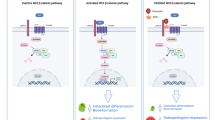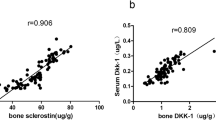Abstract
Paget disease of bone is a chronic metabolic bone disorder characterized by increased bone resorption and new bone formation. The aim of this study is defining the role of inhibitors of canonical Wnt/b-catenin signaling pathway in patients with Paget disease of bone. Scarce and contrasting results have been reported in literature. We studied 40 patients (15 females and 25 males) with radiological and scintigraphic evidence of Paget disease of bone and 40 healthy subjects matched by age and sex. N-propeptide of type I collagen, C-terminal telopeptide of type I collagen, sclerostin, and Dickkopf-related protein 1 (DKK1) were evaluated by blood samples in our laboratory. As expected, mean serum levels of bone turnover markers (N-propeptide of type I collagen and C-terminal telopeptide of type I collagen) were significantly higher in the Paget disease of bone group compared with the control group. No difference was observed between groups in Dickkopf-1 and sclerostin. Dickkopf-1 and sclerostin were never correlated with each other or with bone turnover markers. Sclerostin was positively correlated with age. In conclusion, our results suggest that the regulators of the Wnt-β catenin pathway are not altered in patients with Paget disease of bone. The positive correlation we found between sclerostin and age in Paget disease of bone patients indicates that in comparative studies, sclerostin serum levels must be adjusted for age.

Similar content being viewed by others
References
Galson DL, Roodman GD (2014) Pathobiology of Paget’s disease of bone. J Bone Metab 21(2):85–98
Ralston SH, Langston AL, Reid IR (2008) Pathogenesis and management of Paget’s disease of bone. Lancet 372(9633):155–163
Vega D, Maalouf NM, Sakhaee K (2007) Clinical review #: the role of receptor activator of nuclear factor-kappaB (RANK)/RANK ligand/osteoprotegerin: clinical implications. J Clin Endocrinol Metab 92(12):4514–4521
Baron R, Rawadi G (2007) Targeting the Wnt/beta-catenin pathway to regulate bone formation in the adult skeleton. Endocrinology 148(6):2635–2643
Nakashima T, Hayashi M, Fukunaga T, Kurata K, Oh-Hora M, Feng JQ et al (2011) Evidence for osteocyte regulation of bone homeostasis through RANKL expression. Nat Med 17(10):1231–1234
Xiong J, Onal M, Jilka RL, Weinstein RS, Manolagas SC, O’Brien CA (2011) Matrix-embedded cells control osteoclast formation. Nat Med 17(10):1235–1241
Wijenayaka AR, Kogawa M, Lim HP, Bonewald LF, Findlay DM, Atkins GJ (2011) Sclerostin stimulates osteocyte support of osteoclast activity by a RANKL-dependent pathway. PLoS One 6(10):e25900
Fujita K, Janz S (2007) Attenuation of WNT signaling by DKK-1 and -2 regulates BMP2-induced osteoblast differentiation and expression of OPG, RANKL and M-CSF. Mol Cancer 6:71
Rossini M, Viapiana O, Adami S, Fracassi E, Idolazzi L, Dartizio C et al (2015) In patients with rheumatoid arthritis, Dickkopf-1 serum levels are correlated with parathyroid hormone, bone erosions and bone mineral density. Clin Exp Rheumatol 33(1):77–83
Rossini M, Adami S, Zanotti R, Viapiana O, Idolazzi L, Biondan M et al (2014) Serum levels of bone cytokines in indolent systemic mastocytosis associated with osteopenia or osteoporosis. J Allergy Clin Immunol 133(3):933–935
Gatti D, Rossini M, Viapiana O, Povino MR, Liuzza S, Fracassi E et al (2013) Teriparatide treatment in adult patients with osteogenesisimperfecta type I. Calcif Tissue Int 93(5):448–452
Viapiana O, Fracassi E, Troplini S, Idolazzi L, Rossini M, Adami S et al (2013) Sclerostin and DKK1 in primary hyperparathyroidism. Calcif Tissue Int 92(4):324–329
Rossini M, Gatti D, Adami S (2013) Involvement of WNT/β-catenin signaling in the treatment of osteoporosis. Calcif Tissue Int 93(2):121–132
Tomei P, Zaza G, Granata S, Gatti D, Fraccarollo C, Gesualdo L et al (2014) Sclerostin and Dickkopf-1 in post-menopausal renal allograft recipients. Transplant Proc 46(7):2241–2246
Radetti G, Franceschi R, Adami S, Longhi S, Rossini M, Gatti D (2014) Higher circulating parathormone is associated with smaller and weaker bones in obese children. Calcif Tissue Int 95(1):1–7
Gatti D, Viapiana O, Idolazzi L, Fracassi E, Rossini M, Adami S (2011) The waning of teriparatide effect on bone formation markers in postmenopausal osteoporosis is associated with increasing serum levels of DKK1. J Clin Endocrinol Metab 96(5):1555–1559
Gatti D, Viapiana O, Adami S, Idolazzi L, Fracassi E, Rossini M (2012) Bisphosphonate treatment of postmenopausal osteoporosis is associated with a dose dependent increase in serum sclerostin. Bone 50(3):739–742
Gatti D, Viapiana O, Fracassi E, Idolazzi L, Dartizio C, Povino MR et al (2012) Sclerostin and DKK1 in postmenopausal osteoporosis treated with denosumab. J Bone Miner Res 27(11):2259–2263
Gatti D, Viapiana O, Idolazzi L, Fracassi E, Ionescu C, Dartizio C et al (2014) Distinct effect of zoledronate and clodronate on circulating levels of DKK1 and sclerostin in women with postmenopausal osteoporosis. Bone 67:189–192
Beauregard M, Gagnon E, Guay-Bélanger S, Siris ES, Morissette J, Brown JP et al (2013) Genetic association study of Dickkopf-1 and sclerostin genes with Paget disease of bone. Calcif Tissue Int 93(5):405–412
Yavropoulou MP, van Lierop AH, Hamdy NAT, Rizzoli R, Papapoulos SE (2012) Serum sclerostin levels in Paget’s disease and prostate cancer with bone metastases with a wide range of bone turnover. Bone 51(1):153–157
Polyzos SA, Anastasilakis AD, Litsas I, Sapranidis M, Efstathiadou Z, Kita M et al (2010) Dual-energy X-ray absorptiometry and quantitative ultrasound in patients with Paget’s disease of bone before and after treatment with zoledronic acid: association with serum bone markers and Dickkopf-1. J Clin Densitom 13(2):190–196
Marshall MJ, Evans SF, Sharp CA, Powell DE, McCarthy HS, Davie MWJ (2009) Increased circulating Dickkopf-1 in Paget’s disease of bone. Clin Biochem 42(10–11):965–969
Albagha OME, Wani SE, Visconti MR, Alonso N, Goodman K, Brandi ML et al (2011) Genome-wide association identifies three new susceptibility loci for Paget’s disease of bone. Nat Genet 43(7):685–689
Ross AC, Taylor CL, Yaktine AL, Del Valle HB (eds) (2011) Dietary Reference Intakes for Calcium and Vitamin D. Institute of Medicine (US) Committee to Review Dietary Reference Intakes for Vitamin D and Calcium. National Academies Press (US), Washington (DC)
Kuipers AL, Zhang Y, Yu S, Kammerer CM, Nestlerode CS, Chu Y et al (2014) Relative influence of heritability, environment and genetics on serum sclerostin. Osteoporos Int 25(3):905–912
Acknowledgements
We thank Caterina Fraccarollo and Cristina Bosco for the ELISA assays.
Author information
Authors and Affiliations
Corresponding author
Ethics declarations
Conflict of interest
Dr. Idolazzi reports personal fees from Abbvie, personal fees from Novartis, personal fees from Eli Lilly, and personal fees from UCB, outside the submitted work.
Dr. Fassio has nothing to disclose.
Dr. Tripi has nothing to disclose.
Dr. Braga has nothing to disclose.
Dr. Viapiana reports personal fees from Abiogen, personal fees from Amgen, and personal fees from Merck Sharp & Dohme Corp, outside the submitted work.
Dr. Adami has nothing to disclose.
Prof. Rossini reports personal fees from Abiogen, personal fees from Amgen, personal fees from Merck Sharp & Dohme Corp, and personal fees from Eli Lilly, outside the submitted work.
Prof. Gatti reports personal fees from Abiogen, personal fees from Amgen, personal fees from Merck Sharp & Dohme Corp, and personal fees from Eli Lilly, outside the submitted work.
Rights and permissions
About this article
Cite this article
Idolazzi, L., Fassio, A., Tripi, G. et al. Circulating Dickkopf-1 and sclerostin in patients with Paget’s disease of bone. Clin Rheumatol 36, 925–928 (2017). https://doi.org/10.1007/s10067-016-3497-1
Received:
Revised:
Accepted:
Published:
Issue Date:
DOI: https://doi.org/10.1007/s10067-016-3497-1




